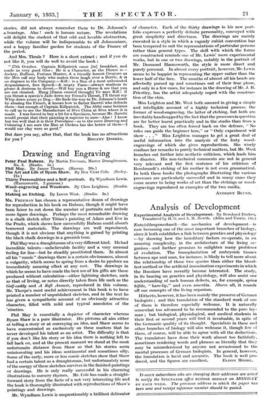Drawing and Engraving
Peter Paul Rubens. By Martin Freeman, Master Draughtsmen. No. 3. (Studio. 5s.)
Phil May. By James Thorpe. (Harrap. 30s.)
Making an Etching. By Levou West. (Studio. 5s.) MR. FREEMAN has chosen a representative dozen of drawings for reproduction in his book on Rubens, though it might have been fairer to cut down the number of portraits and include more figure drawings. Perhaps the most remarkable drawing is a chalk sketch after Titian's painting of Adam and Eve in the Prado, which shows how successfully Rubens could absorb borrowed materials. The drawings are well reproduced, though it is not obvious that anything is gained by printing the black chalk drawings in a greenish tone.
Phil May was a draughtsman of a very different kind. He had incredible talents—unbelievable facility and a very unusual feeling for line—but he steadily prostituted them. In almost all his "comic" drawings there is a certain obviousness, almost a vulgarity, which seems to spring from a desire to produce an immediately amusing effect at any cost. The drawings in which he seems to have made the best use of his gifts are those produced without calculation—either lightning sketches, such as that of Irving, or notes directly taken from life such as the Golf-caddy and A Soft Answer, reproduced in this volume. Mr. Thorpe's most useful achievement in this book is to have printed a number of unpublished sketches, and in the text he has given a sympathetic account of an obviously attractive character, filled with mild and typical anecdotes of the 'nineties.
Phil May is essentially a depictor of character whereas Byam Shaw is a pure illustrator. His pictures all aim either at telling a story or at conveying an idea, and Shaw seems to have concentrated so exclusively on these matters that he never developed his talent as an artist. The difficulty is that if you don't like his story or his idea there is nothing left to fall back on, and at the present moment we stand at the most unfortunate distance from Shaw so that his stories seem uninteresting and his ideas sentimental and sometimes silly. Some of the early, more or less comic sketches show that Shaw had a certain talent as a draughtsman, but unfortunately none of the energy of these sketches survives in the finished paintings or drawings. He is only really successful in his charming illustrations to nursery rhymes. Mr. Cole has made a straight- forward story from the facts of a not very interesting life and the hook is thoroughly illustrated with reproductions of Shaw's paintings and drawings.
Mr. Wyndham Lewis is unquestionably a brilliant delineator
of character. Each of the thirty drawings in his new port' folio expresses a perfectly definite personality, conveyed with great simplicity and directness. The drawings are mainly executed- in a style in which a vaguely cubist convention has been tempered to suit Use representations of particular persons rather than general types. The skill with which the forms are constructed reminds one of Mr. Lewis' more experimental works, but in one or two drawings, notably in the portrait of Mr. Desmond Harmsworth, the style is more direct and purely personal. In almost every portrait, however, Mr. Lewis seems to be happier in representing the upper rather than the lower half of the face. The mouths of almost all his heads are affectedly pursed up and sometimes out of their. true plane, and only in a few cases, for instance in the drawing of Mr. .1. B. .Priestley, has the artist adequately coped with the construc- tion of the chin.
Miss Leighton and Mr. West both succeed in giving a simple and intelligible account of a highly technical process, the former of wood-engraving, the latter of etching, but both are inevitably handicapped by the fact that the processes in question are far better learnt practically and in the studio than from a book. They are too often forced back on the defence, " No rules can guide the beginner here," or "Only experiment will show . . " Miss Leighton manages to get a great deal of useful information into the analysis of the forty wood- engravings of which she gives reproductions. She wisely confines her remarks to purely technical matters, but Mr. West launches out further into aesthetic criticism, which leads him to disaster. Ills non-technical comments are not in general very relevant and the first sentence of his criticism of Rembrandt's etching of his mother is not even grammatical. In both these books the photographs illustrating the various processes are particularly successful and in many cases they come nearer to being works of art than the etchings or wood. engravings reproduced as examples of the two media.
ANTHONY BLUNT.




































 Previous page
Previous page